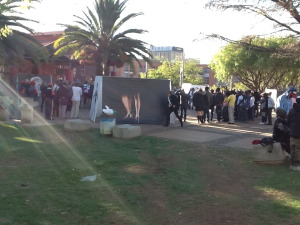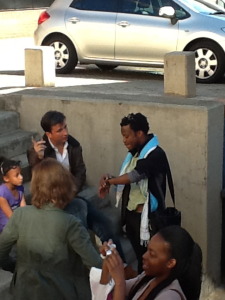Today I was able to have lunch with Gregory Maqoma and Vincent Mantsoe — old friends who starting dancing together as teens in Soweto. They rarely have a chance to see one another these days so it was a happy gathering for all of us. We lunched in Sophiatown a series of outdoor cafes which sit between Dance Factory and the Market Theatre on a big park. This spot has been designated as the “green room” for the festival where folks can meet, eat and talk. If only there were more time allotted for that!
Each time I have a chance to be with these two exceptional choreographer/performers I learn so much. Not only was it great just to catchup as friends on our lives and work, but their perspective on dance in Africa and Europe (where they do much of their work) is always insightful and helpful to our effort to find meaningful ways to engage across the Atlantic.
Vincent now live in central France with his family where he has built a home studio to develop work with his company. Fortunately he is receiving some support from the French to sustain his creative work. Greg who is a real globetrotter these days, is fortunate to have a studio and office in a building shared with Dance Forum and next to Dance Factory and Moving Into Dance — a little dance hub in Newtown. Vincent is currently touring a new solo program that was recently presented by our Africa Consortium partner, North Fourth Art Center in Albuquerque, NM. They are both major success stories coming out of the South African contemporary dance scene along with Boyzie Cekwana, Neli Xaba, Sello Pesa and others.
After a luxurious lunch it was time to head back into the theater for a marathon afternoon/evening of shows.
In quick succession we saw Faustin Linyekula‘s newest solo, “Cargo”, which I found profoundly moving and brilliantly crafted. “Cargo” tells, in intimate terms, of a personal journey back to Faustin’s village to discover/uncover the forbidden dances of his childhood. The ones that happened after dark, after he was sent to bed, the ones he was not allowed to participate in. Throughout the work he asks himself if he has really danced over the last ten years as a performer. He threads the story of the villages’ master drummer thru the narrative. A revered musician who, with the coming of a new wave of missionaries after the war, gave up the drum and turned into a christian preacher. Personally I felt the sequencing of text and dance, a narrative masterfully weaving the personal and political, the repetition of sections, and the use of simple technical tools made this piece extremely affecting.I didn’t want to watch anything else but just to sit with the feelings “Cargo” evoked.
But alas we are at a festival of marathon proportions. The next three pieces were interminably long, needed extreme editing, and frankly, were exhausting to sit through. The question that keeps arising, as piece after piece feels much too long for its own good, is what in fact are the core goals of Danse Afrique Danse? Is it to serve the African artists at all levels of maturity and give them a much needed performance platform – a very worthy goal. Is it to serve the presenters who have come from all over the globe to see and “buy” work – also a much appreciated opportunity to see these artists in a technically produced format? I question the benefits of placing very accomplished and emerging artists side by side on a level playing field and offering no distinguishing context. I wonder why so many works are being packed into the schedule since it clearly is a logistically nightmare from the venue/production standpoint and has allowed us viewers so little time to digest the work and formulate a response, never mind having time to eat a decent meal.
One thing is very clear–there is a tremendous need for more access to compositional tools, choreographic training, dramaturgy/choreoturgy, and mentoring, as well as dance technique training which we know is not available to many aspiring artists across the continent, though efforts are being made and things are improving little by little.
I assume what drives the choice to make over long works is the demand of the marketplace. It is likely that most artists assume no presenter will book a piece shorter than 30 minutes. And this is probably true. But when the piece really should be 10 minutes and goes on for thirty it is dead upon arrival!
The last piece of the night was the site-specific work, “Shift” by Mamela Nyamza (who was at BDF in 2011) and took place in the Wits Art Museum. Due to the location of the piece, in a corner window, it was not easy to view. But i managed a good set on the floor and thoroughly enjoyed this charismatic performer as she took us along on a funny romp about female transformation.
Way too late to find dinner and too exhausted we called it a night.



